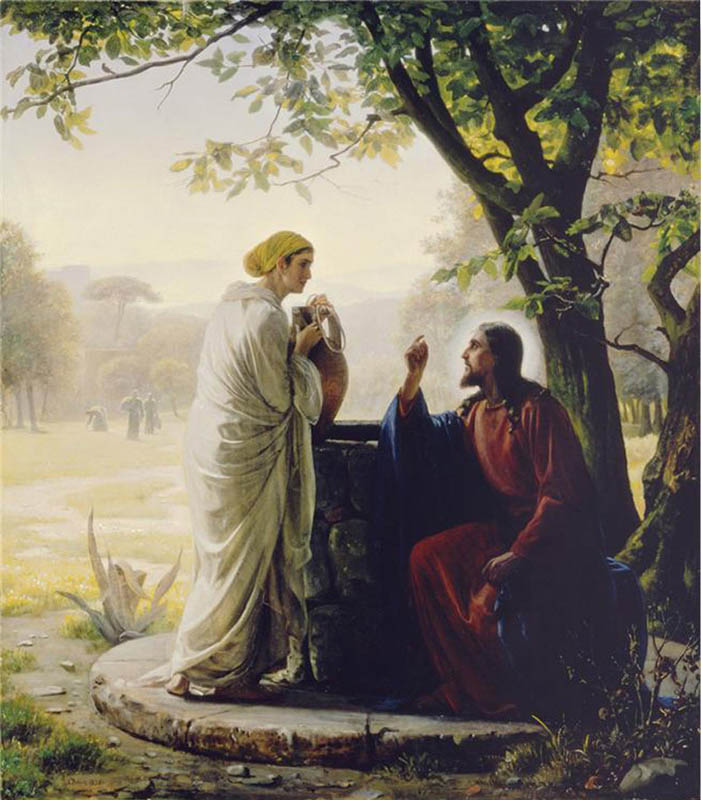
And by ‘the woman at the well’ I mean the ‘woman of Samaria’ of John 4. You know, the fattest woman in the Bible (the “woman of some area”… geddit? GEDDIT? HAHAHAHA! Sorry.)
Anyway, we were studying John 4 in our class a couple of weeks ago, and I really enjoyed it. In our class on John, each of us has been assigned a commentary to look at and every week we look at it and write a couple of sheets summary on what it says, any exegetical issues and questions we have etc. I’ve really benefited from it – I’ve been using Andrew Lincoln’s commentary, which I’ve found to be excellent. Although I don’t agree with everything – he probably takes a more ‘open’ evangelical line on certain issues, and if you don’t know what that means don’t worry – but in general his exegetical insight and theological grasp of the text have been very helpful to me.
This chapter is a case in point. As with virtually every chapter in John, it is theologically rich and there is much you could say about it. I’m going to restrict myself to one topic though, something which I don’t think the ‘blessed Don’ (as our tutor describes Don Carson) picks up in his commentary: the idea of this passage being a betrothal scene. When I say ‘betrothal scene’, I mean an Old Testament betrothal scene like that described in Genesis 24.
First things first, wells / cisterns in the Old Testament are often a symbol of faithfulness, i.e. marital fidelity. So, Jeremiah 2:13 “‘My people have committed two sins: They have forsaken me, the spring of living water, and have dug their own cisterns, broken cisterns that cannot hold water.” Or Proverbs 5:15 “Drink water from your own cistern, running water from your own well.” (It’s in the context of marriage, see vv16-20, but I think the idea is pretty clear…)
It should also be noted that Jesus, when he performed his first miracle (or ‘sign’ in John’s gospel) at Cana – turning water into wine – was performing the role of the bridegroom: apparently, it was the bridegroom’s job to provide wine at a wedding in those days.
So, given all that, let’s take a quick look at some of the parallels between this passage and Genesis 24:
- Jesus sits down by a well, tired; in 24:11 Abraham’s servant makes his camels kneel by a well (presumably tired, near the end of the day!)
- Jesus asks a Samaritan (a woman not from his own country) for water; in 24:17 the servant asks Rebekah for water
- The Samaritan woman goes back to the town to tell everyone about Jesus; in 24:28 Rebekah runs off to tell her mother’s household
- Jesus is urged to stay for two days (he is offered hospitality and talks about ‘food’); in 24:54 the servant stays the night with Rebekah’s family after a meal.
What I find fascinating about all this is how the betrothal scene is taken and widened / subverted. For example, whereas in the standard betrothal scene the bridegroom is offered a meal, in John 4 Jesus says “my food is to do the will of him who sent me” (v34). The chapter in Genesis portrays Rebekah as a virtuous woman, whereas in John 4 the Samaritan woman has had five husbands, and is living with a man who is not her husband (v18).
Now all this is very interesting, but what does it actually mean? I think this is where we get the payoff from this particular passage. At this point, I’m just going to quote from Lincoln because I don’t think I can do better:
Jesus, as the unique representative of God who is one with God, is presented as the bridegroom seeking a bride, the new people of God. Represented by the Samaritan woman, the new bride turns out to include women as well as men, Samaritans as well as Jews, and those with dubious pasts who would normally have been considered to be impure. Jesus overturns the usual conventions in choosing his bride. His new covenant bride transcends ethnic, gender and purity divisions so that Jesus as bridegroom can be confessed as truly the Saviour of the world. In this light the water he offers is neither simply that which quenches thirst nor that which gives rise to sexual overtones but represents the revelation from God that is life-giving and that is mediated by the Spirit.
Isn’t that amazing? A simple scene at a well – but where Jesus reveals himself to be the bridegroom, who is seeking at bride. (This is particularly profound when you consider that marriage is often a Biblical picture of Christ and the Church – see Ephesians 5:25-33; Revelation 21:1-4). The bride is actually not perfect – not a perfect model of beauty, not someone the world might consider desirable – but whom Christ has chosen to redeem. The views of the world are overturned as Jesus seeks the weak and despised things of the world to shame the strong.
I find it quite staggering that one can read such profound theological truths from a story about a woman and a well. But I found it helpful to think about this, and once again it makes me thankful for the riches of God’s word!
Leave a Reply